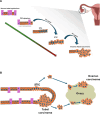From Fallopian Tube to Ovarian Cancer: Understanding the Evaluation and Management of Serous Tubal Intraepithelial Carcinoma Lesions
- PMID: 40911247
- PMCID: PMC12511240
- DOI: 10.1007/s11864-025-01346-0
From Fallopian Tube to Ovarian Cancer: Understanding the Evaluation and Management of Serous Tubal Intraepithelial Carcinoma Lesions
Abstract
Ovarian cancer, particularly high-grade serous carcinoma (HGSC), remains a leading cause of mortality in gynecologic oncology. Emerging research identifies serous tubal intraepithelial carcinoma (STIC) as a precursor lesion in many HGSC cases, highlighting its role in ovarian cancer pathogenesis and prevention. Management of STIC is challenging, as there is only limited data available to guide clinical decision-making. For average-risk women, opportunistic salpingectomy is increasingly being adopted during routine procedures such as hysterectomy or cesarean section. This intervention has demonstrated significant potential in reducing ovarian cancer incidence while maintaining safety and feasibility. For high-risk individuals, particularly BRCA mutation carriers, risk-reducing salpingo-oophorectomy (RRSO) remains the gold standard. RRSO significantly lowers ovarian cancer risk, though alternative approaches like salpingectomy alone or radical fimbriectomy are under investigation to preserve ovarian function in younger patients. To improve STIC detection, SEE-FIM pathology protocol is recommended when patients are undergoing risk-reducing surgery to prevent ovarian cancer, but challenges such as diagnostic variability and limited data persist. When STIC is detected incidentally, management varies based on risk factors and lesion characteristics. Genetic counseling and testing are essential when STIC is identified, as hereditary predisposition may guide further management. Surgical management is advised for cases of STIC with microinvasive carcinoma, but routine use of surgical management for STIC is not clearly defined in the literature. Bilateral oophorectomy is generally recommended when STIC is identified, and adnexal structures have not yet been removed. Chemotherapy is not recommended for treatment of STIC. Surveillance is suggested when STIC has been diagnosed, but there are no set guidelines as to the frequency and type of monitoring. Future directions include refining molecular profiling to predict progression and conducting randomized studies to establish evidence-based guidelines. Multidisciplinary collaboration is essential to optimize prevention and treatment, ultimately reducing HGSC incidence and improving patient outcomes.
Keywords: BRCA; High grade serous cancer; Ovarian cancer; Peritoneal cancer; Risk reducing salpingo-oophorectomy; STIC.
© 2025. The Author(s).
Conflict of interest statement
Declarations. Competing interests: The authors declare no competing interests.
Figures
References
-
- Ferlay J, Steliarova-Foucher E, Lortet-Tieulent J, Rosso S, Coebergh JW, Comber H, et al. Cancer incidence and mortality patterns in Europe: estimates for 40 countries in 2012. Eur J Cancer. 2013;49(6):1374–403. 10.1016/j.ejca.2012.12.027. - PubMed
-
- Braicu EI, Sehouli J, Richter R, Pietzner K, Denkert C, Fotopoulou C. Role of histological type on surgical outcome and survival following radical primary tumour debulking of epithelial ovarian, fallopian tube and peritoneal cancers. Br J Cancer. 2011;105(12):1818–24. 10.1038/bjc.2011.455. - PMC - PubMed
-
- Henderson JT, Webber EM, Sawaya GF. Screening for ovarian cancer: an updated evidence review for the US preventive services task force. U.S. preventive services task force.evidence syntheses, formerly systematic evidence reviews. Rockville (MD) 2018.
Publication types
MeSH terms
LinkOut - more resources
Full Text Sources
Medical


